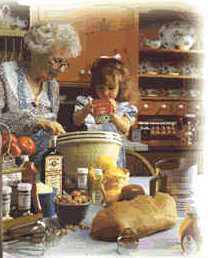 Storing and Sending Your Holiday Cookies
In these busy, busy
times, many of us can't take an entire week before the holiday season to
do our baking, so we do a bit and a batch at a time slowly once Labour Day
is over. The question is, how do we keep our treasures at their
"peak" until the big moment arrives? Here are some ideas to help
make your holiday cookies taste like you just baked them:
 Mix now, bake
later! Mix now, bake
later!
- Most cookie dough can be mixed, then refrigerated
or frozen for baking later. The exceptions are bar-cookie batters,
and meringue or macaroon mixtures.
- Pack dough into freezer containers, or shape
slice-and-bake dough into rolls and wrap in foil. Store in a tightly
covered container in the refrigerator up to one week, or freeze up to six
months.
- Before baking, thaw frozen dough in the container
in the refrigerator. If the dough is too stiff to work with, let
it stand at room temperature to soften.
Baking
to perfection!
- Bake cookies on the middle oven rack.
For soft and chewy cookies, under bake slightly - for crisper cookies,
bake a little longer. If you're not too sure, the best idea is
under bake - you can then put them back for a bit if they are too soft,
but you can't "unbake" what's too crisp!
- Oven temperatures can vary slightly from
oven to oven, so always be sure to set your timer for the minimum time
recommended. Remember, time is the one thing you can add more of
at the last minute, but you can never take it away!
- When baking bars, loaves or brownies, it
is important to use the correct pan size according to the recipe - a pan
too small could cause your batter to overflow or the edges to be
overcooked while the center remains raw; and a too big pan could result
in a drier texture and a flatter cake or loaf.

Storing baked
cookies
Follow these four basic rules for storing
cookies after baking:
-
Make sure cookies are completely cooled before
storing.
-
Store cookies unfrosted; frosting may cause them
to stick together. Also, cookies tend to absorb moisture from the
frosting and lose their crispness.
-
Store crisp and soft cookies separately.
Stored together, all become soft.
-
Use tightly covered containers or sealed plastic
bags.
-
You can store cookies at room temperature up
to three days.
-
Store bar cookies tightly covered in a container or
in their own baking pan.
-
Cookies with a frosting or filling that contains
cream cheese or yoghurt must be stored in the refrigerator.

Freezing cookies
- Most drop, sliced, bar, and shaped cookies
freeze well. If the cookies are to be frosted or glazed, wait till
they are thawed.
- Freeze cookies in layers separated by sheets of
waxed paper. To thaw, let the cookies stand about 15 minutes in the
container at room temperature.
- If you plan to freeze bar cookies, line the
baking pan with foil, leaving 2 inches extra foil at each end. Add
the batter, bake, and cool in the line pan. then lift the foil to
remove the cooled cookie. Wrap in foil, seal, and freeze. Frost
and cut after thawing.
 Cookies by mail Cookies by mail
- Crisp cookies stay fresher during shipping
than moist ones.
- Slice-and-bake cookies and most drop and uncut bar
cookies are good travellers.
- Frosted and filled cookies are not good
for shipping because they may stick to each other or to the wrappings.
- For cut-out cookies, choose simple shapes; shapes with points or narrow
areas tend to break easily during shipping.
- Package gifts in plastic- or foil-lined heavy
boxes.
- Make generous cushions of filler, such as plastic bubble wrap,
foam packing pieces, or crumpled tissue paper.
- Wrap cookies with plastic wrap
individually or in back-to-back pairs.
- Pack in layers with the sturdiest
cookies on the bottom, then a layer of filler.
- Continue layering, and end with more
filler to prevent shifting.
- Insert a card with the recipient's
address.
- Tape the box shut with strapping tape
and mark it "perishable".
- Cover the outside address with
transparent tape.
 |

 Mix now, bake
later!
Mix now, bake
later!


 Cookies by mail
Cookies by mail
